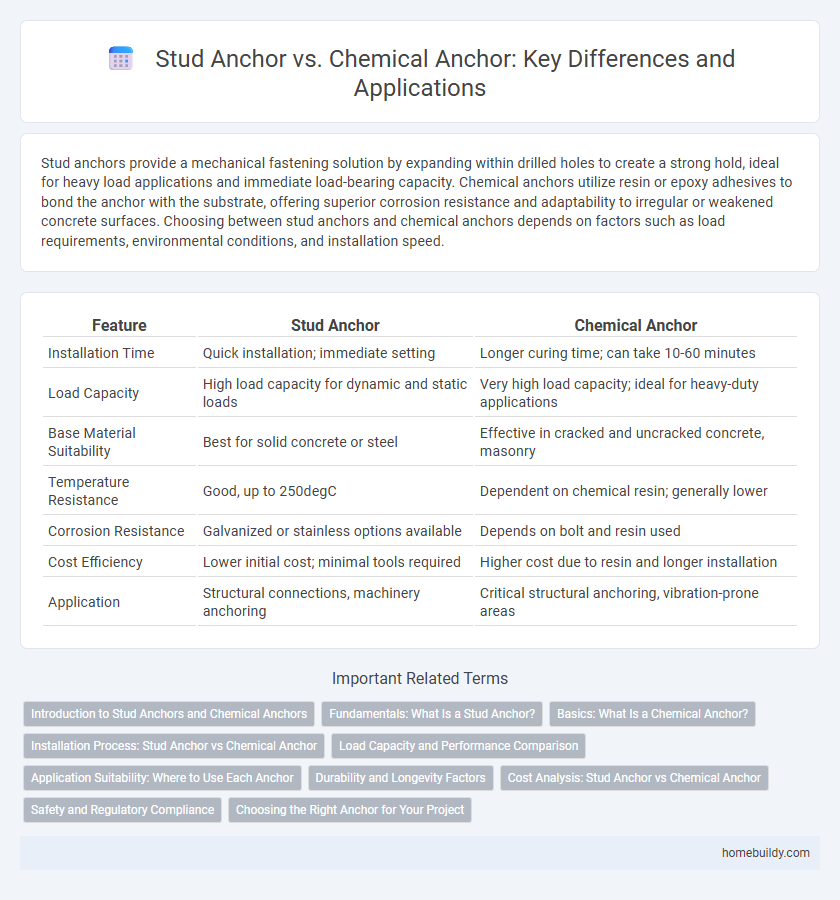Stud anchors provide a mechanical fastening solution by expanding within drilled holes to create a strong hold, ideal for heavy load applications and immediate load-bearing capacity. Chemical anchors utilize resin or epoxy adhesives to bond the anchor with the substrate, offering superior corrosion resistance and adaptability to irregular or weakened concrete surfaces. Choosing between stud anchors and chemical anchors depends on factors such as load requirements, environmental conditions, and installation speed.
Table of Comparison
| Feature | Stud Anchor | Chemical Anchor |
|---|---|---|
| Installation Time | Quick installation; immediate setting | Longer curing time; can take 10-60 minutes |
| Load Capacity | High load capacity for dynamic and static loads | Very high load capacity; ideal for heavy-duty applications |
| Base Material Suitability | Best for solid concrete or steel | Effective in cracked and uncracked concrete, masonry |
| Temperature Resistance | Good, up to 250degC | Dependent on chemical resin; generally lower |
| Corrosion Resistance | Galvanized or stainless options available | Depends on bolt and resin used |
| Cost Efficiency | Lower initial cost; minimal tools required | Higher cost due to resin and longer installation |
| Application | Structural connections, machinery anchoring | Critical structural anchoring, vibration-prone areas |
Introduction to Stud Anchors and Chemical Anchors
Stud anchors consist of a threaded stud bonded directly into pre-drilled holes using high-strength adhesives, offering fast curing times and high load capacities for structural applications. Chemical anchors utilize epoxy or polyester resins to secure threaded rods or rebar, providing superior corrosion resistance and flexibility in various substrate conditions. Both anchors serve critical roles in construction, with stud anchors excelling in quick installation and chemical anchors preferred for enhanced bonding strength in cracked concrete.
Fundamentals: What Is a Stud Anchor?
A stud anchor is a mechanical fastener designed to securely attach objects to concrete or masonry surfaces by embedding a threaded stud into a drilled hole using expansion or friction principles. Unlike chemical anchors, which rely on adhesive bonding with resins and hardeners, stud anchors provide immediate load-bearing capacity and are often preferred for high-strength, vibration-resistant applications. Understanding the fundamental distinction between stud and chemical anchors is essential for selecting the appropriate fastening solution based on installation speed, load requirements, and environmental conditions.
Basics: What Is a Chemical Anchor?
A chemical anchor is a high-strength adhesive used to secure studs or rebar into concrete, providing a reliable bond through a resin-based compound that cures inside drilled holes. Unlike stud anchors, which rely on mechanical expansion or friction, chemical anchors distribute load by bonding directly to the concrete substrate. This adhesive system is especially beneficial in applications requiring minimal vibration, corrosion resistance, and superior load-bearing capacity.
Installation Process: Stud Anchor vs Chemical Anchor
Stud anchors offer a straightforward installation process involving drilling a hole, cleaning it thoroughly, and driving the anchor directly into the substrate, ensuring quick load-bearing capacity. Chemical anchors require mixing and injecting a resin-based adhesive into the drilled hole before inserting the threaded rod or bolt, demanding longer curing times for optimal strength. The simpler, faster installation of stud anchors often results in reduced labor costs and immediate fixture support compared to the precision and waiting period essential for chemical anchors.
Load Capacity and Performance Comparison
Stud anchors exhibit superior load capacity compared to chemical anchors due to their mechanical expansion design, ensuring robust holding power in both tension and shear forces. Unlike chemical anchors, stud anchors allow immediate load application without curing time, enhancing construction efficiency. Their consistent performance in dynamic and seismic conditions makes them preferable for high-demand structural applications.
Application Suitability: Where to Use Each Anchor
Stud anchors provide high load capacity and are ideal for heavy-duty applications such as structural steel connections, machinery fixing, and infrastructure projects requiring immediate high strength. Chemical anchors excel in applications with limited edge distance, cracked concrete, or irregular base materials, offering superior adhesion and flexibility for retrofit or repair work. Selecting between stud and chemical anchors depends on factors such as load requirements, substrate condition, and installation environment.
Durability and Longevity Factors
Stud anchors offer superior durability compared to chemical anchors due to their mechanical interlock and resistance to environmental degradation. Their metal construction withstands extreme temperatures, moisture, and corrosive conditions better than chemical adhesives, which may weaken over time under similar stress. The longevity of stud anchors is reinforced by consistent material performance and minimal dependency on curing conditions, ensuring reliable load-bearing capacity in demanding applications.
Cost Analysis: Stud Anchor vs Chemical Anchor
Stud anchors typically offer a lower upfront cost compared to chemical anchors, making them a budget-friendly choice for large-scale construction projects. While chemical anchors may incur higher initial expenses due to specialized installation and adhesive materials, they often provide superior bonding strength and corrosion resistance. Evaluating the total cost of ownership involves considering not only installation price but also long-term maintenance and performance reliability in structural applications.
Safety and Regulatory Compliance
Stud anchors provide superior safety due to their mechanical expansion and high load-bearing capacity, meeting stringent regulatory standards for structural integrity. Unlike chemical anchors, which rely on adhesives that may degrade over time or under adverse conditions, stud anchors ensure consistent performance in harsh environments without chemical hazards. Compliance with industry codes like ACI 318 and ICC bolsters stud anchors' reliability in critical applications, making them a preferred choice for safety-conscious construction projects.
Choosing the Right Anchor for Your Project
Stud anchors provide reliable mechanical fastening with high load capacity and immediate set time, ideal for heavy-duty applications requiring quick installation. Chemical anchors offer superior bonding strength in cracked or porous substrates, ensuring enhanced durability in challenging conditions. Selecting between stud anchors and chemical anchors depends on substrate type, load requirements, and curing time constraints for optimal project performance.
Stud anchor vs chemical anchor Infographic

 homebuildy.com
homebuildy.com